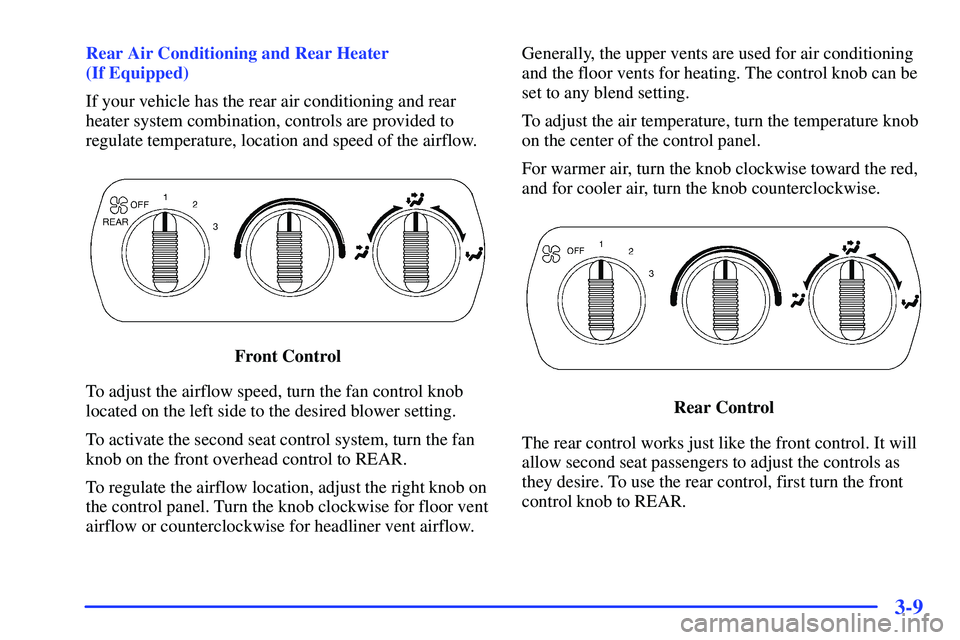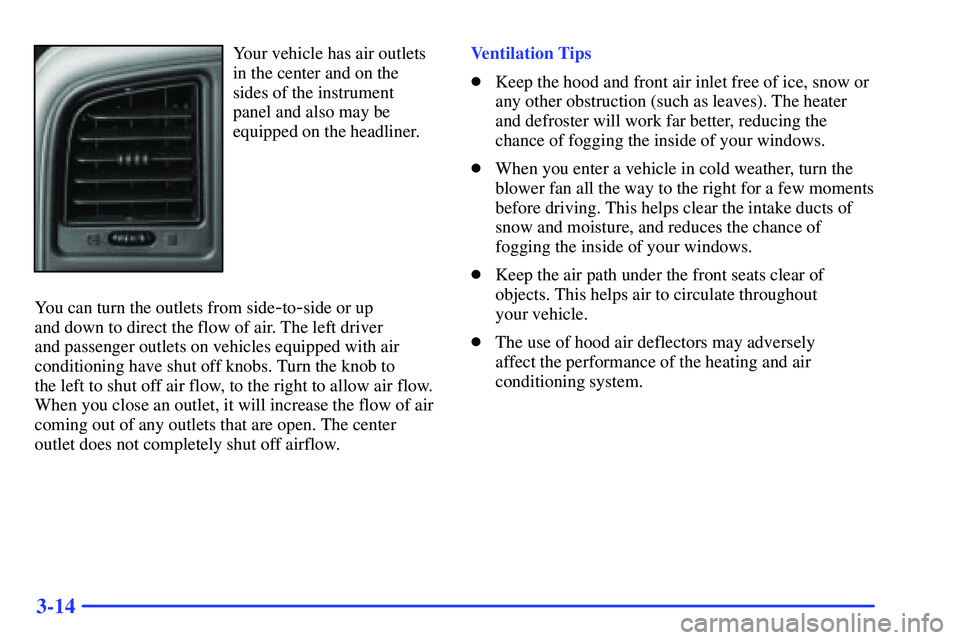Page 174 of 413

3-9
Rear Air Conditioning and Rear Heater
(If Equipped)
If your vehicle has the rear air conditioning and rear
heater system combination, controls are provided to
regulate temperature, location and speed of the airflow.
Front Control
To adjust the airflow speed, turn the fan control knob
located on the left side to the desired blower setting.
To activate the second seat control system, turn the fan
knob on the front overhead control to REAR.
To regulate the airflow location, adjust the right knob on
the control panel. Turn the knob clockwise for floor vent
airflow or counterclockwise for headliner vent airflow.Generally, the upper vents are used for air conditioning
and the floor vents for heating. The control knob can be
set to any blend setting.
To adjust the air temperature, turn the temperature knob
on the center of the control panel.
For warmer air, turn the knob clockwise toward the red,
and for cooler air, turn the knob counterclockwise.
Rear Control
The rear control works just like the front control. It will
allow second seat passengers to adjust the controls as
they desire. To use the rear control, first turn the front
control knob to REAR.
Page 175 of 413

3-10 Rear Air Conditioning and Heating Systems
with Electronic Climate Control System
(If Equipped)
Front Control
Rear ControlWith this system the rear passengers can control the
temperature of the air flow for his/her own zones.
The climate control has three controls.
To adjust the airflow speed, turn the fan control knob
located on the left side of the control panel to the desired
blower setting.
The system also has a front AUTO setting that can
automatically change the temperature of the rear seating
area based on information from the front control. An
OFF setting, located on the front climate control panel,
also allows the driver to turn off the rear passenger seat
controls from the front seat.
To adjust the air temperature, turn the temperature knob
on the center of the control panel.
For warmer air, turn the knob clockwise toward the red.
Turn the knob counterclockwise toward the blue for
cooler air.
To regulate the airflow location, adjust the right knob on
the control panel. Turn the knob clockwise for floor vent
airflow or counterclockwise for headliner vent airflow.
Generally, the upper vents are used for air conditioning
and the floor vents for heating. The control knob can be
set to any blend setting.
For rear control operation, use the above instructions.
Page 176 of 413

3-11 Air Conditioning
On hot days, open the windows long enough to let hot
air inside escape. This reduces the time it takes for your
vehicle to cool down. Then keep your windows closed
for the air conditioner to work its best.
The RECIRCULATION button allows the air inside
your vehicle to be recirculated. This setting helps to
maximize your air conditioner's performance and your
vehicle's fuel economy. This setting also cools air the
fastest and can be used to keep unwanted odors
and/or dust from entering the vehicle. When using
the air conditioner, turn off the RECIRCULATION
button after the vehicle reaches a comfortable interior
temperature. When the right knob on the control panel
is between HEATER and DEFROST, the recirculation
feature will not function to reduce window fogging.The A/C button, below the mode knob, allows the air
coming into your vehicle to be cooled. This setting is
useful for normal cooling on hot days. When you use
A/C with the RECIRCULATION button pushed in,
turn off recirculation as soon as the vehicle reaches a
comfortable interior temperature.
Maximum air conditioning performance is obtained by
pressing the A/C button, the RECIRCULATION button
and turning the temperature knob fully counterclockwise
to the blue area. This setting also cools air the fastest.
After the vehicle's interior reaches a comfortable
temperature, press the OUTSIDE AIR button to
place the air conditioning system in the normal mode.
Passenger Compartment Air Filter (If Equipped)
If your vehicle has air conditioning, it is equipped
with a passenger compartment air filter, which filters
outside air entering the vehicle. For information on
replacing the filter see ªPassenger Compartment
Air Filterº in the Index.
Page 178 of 413

3-13
The defogger will shut itself off after several minutes.
If you need additional warming time, press the button
again. You can turn the defogger off at any time by
pressing the button.
If your vehicle is equipped with heated outside mirrors,
the rear window defogger button will also activate the
heated outside mirrors.
Do not attach a temporary vehicle license, tape or decals
across the defogger grid on the rear window.
NOTICE:
Don't use a razor blade or something else sharp
on the inside of the rear window. If you do, you
could cut or damage the warming grid, and the
repairs wouldn't be covered by your warranty.
Ventilation System
For mild outside temperatures when little heating or
cooling is needed, use VENT to direct outside air
through your vehicle. Air will flow through the
instrument panel outlets.
Your vehicle's ventilation system supplies outside air
to the inside of your vehicle when it is moving. With
the side windows closed, air will flow into the front
air inlet grilles, through the vehicle, and out the air
exhaust valves.
Outside air will also enter the vehicle when the heater
or the air conditioning fan is running, unless you have
the RECIRCULATION button pushed in. For more
information on the RECIRCULATION button,
see ªAir Conditioningº earlier in this section.
Page 179 of 413

3-14
Your vehicle has air outlets
in the center and on the
sides of the instrument
panel and also may be
equipped on the headliner.
You can turn the outlets from side
-to-side or up
and down to direct the flow of air. The left driver
and passenger outlets on vehicles equipped with air
conditioning have shut off knobs. Turn the knob to
the left to shut off air flow, to the right to allow air flow.
When you close an outlet, it will increase the flow of air
coming out of any outlets that are open. The center
outlet does not completely shut off airflow.Ventilation Tips
�Keep the hood and front air inlet free of ice, snow or
any other obstruction (such as leaves). The heater
and defroster will work far better, reducing the
chance of fogging the inside of your windows.
�When you enter a vehicle in cold weather, turn the
blower fan all the way to the right for a few moments
before driving. This helps clear the intake ducts of
snow and moisture, and reduces the chance of
fogging the inside of your windows.
�Keep the air path under the front seats clear of
objects. This helps air to circulate throughout
your vehicle.
�The use of hood air deflectors may adversely
affect the performance of the heating and air
conditioning system.
Page 274 of 413

5-5
4. Open the hoods and locate the positive (+) and
negative (
-) terminal locations on the other vehicle.
Your vehicle has a remote positive (+) jump starting
terminal and a remote negative (
-) jump starting
terminal. The remote positive (+) terminal is located
behind a red plastic cover near the driver's side of the
engine accessory drive bracket. To uncover the remote
positive (+) terminal, open the red plastic cover.
The remote negative (
-) terminal is located on the
engine accessory drive bracket. This is marked ªGNDº
on V8 engines.
You should always use the remote positive (+) and the
remote negative (
-) terminals instead of the positive (+)
and negative (
-) terminals on your battery.
CAUTION:
If your vehicle has air conditioning, the auxiliary
electric fan under the hood can start up even
when the engine is not running and can injure
you. Keep hands, clothing and tools away from
any underhood electric fan.
CAUTION:
Using a match near a battery can cause battery
gas to explode. People have been hurt doing this,
and some have been blinded. Use a flashlight if
you need more light.
Be sure the battery has enough water. You don't
need to add water to the ACDelco� battery
installed in every new GM vehicle. But if a
battery has filler caps, be sure the right amount
of fluid is there. If it is low, add water to take
care of that first. If you don't, explosive gas
could be present.
Battery fluid contains acid that can burn you.
Don't get it on you. If you accidentally get it in
your eyes or on your skin, flush the place with
water and get medical help immediately.
Page 281 of 413
5-12
Cooling System
When you decide it's safe to lift the hood, here's what
you'll see:
A. Coolant Surge Tank
B. Coolant Surge Tank Pressure Cap
C. Engine Fan
CAUTION:
If your vehicle has air conditioning, the auxiliary
electric engine cooling fan under the hood can
start up even when the engine is not running and
can injure you. Keep hands, clothing and tools
away from any underhood electric fan.
If the coolant inside the coolant recovery tank surge tank
tank is boiling, don't do anything else until it cools down.
When the engine is cold,
the coolant level should
be at or above the FILL
COLD mark.
Page 365 of 413

6-62
Name Usage
RR DEFOG Rear Window Defogger,
Heated Mirrors (Relay)
RTD Autoride� (Real Time Damping)
RR PRK Right Rear Parking Lamps
ECM B VCM/PCM
F/PMP Fuel Pump (Relay)
O2 A Oxygen Sensors
O2 B Oxygen Sensors
LR PRK Left Rear Parking Lamps
RR DEFOG Rear Window Defogger,
Heated Mirrors
HDLP Headlamps (Relay)
TRL PRK Parking Lamps Trailer Wiring
PRIME Not Used
RT HDLP Right Headlamps
DRL Daytime Running Lamps (Relay)
HTD MIR Heated Mirrors
LT HDLP Left HeadlampsName Usage
A/C Air Conditioning
AUX PWR Cigarette Lighter, Auxiliary
Power Outlets
SEO 2 Special Equipment Option Power,
Power Seats, Aux Roof Mnt Lamp
SEO 1 Special Equipment Option Power,
Aux Roof Mnt Lamp, Cell Phone
DRL Daytime Running Lamps
A/C A/C (Relay)
FOG LP Fog Lamps
FOG LP Fog Lamps (Relay)
RADIO Audio System, Instrument Cluster,
Climate Control System
CIGAR Cigarette Lighter, Auxiliary
Power Outlets
RT TURN Right Turn Signals
BTSI Automatic Transmission Shift
Lock Control System
LT TURN Left Turn Signals